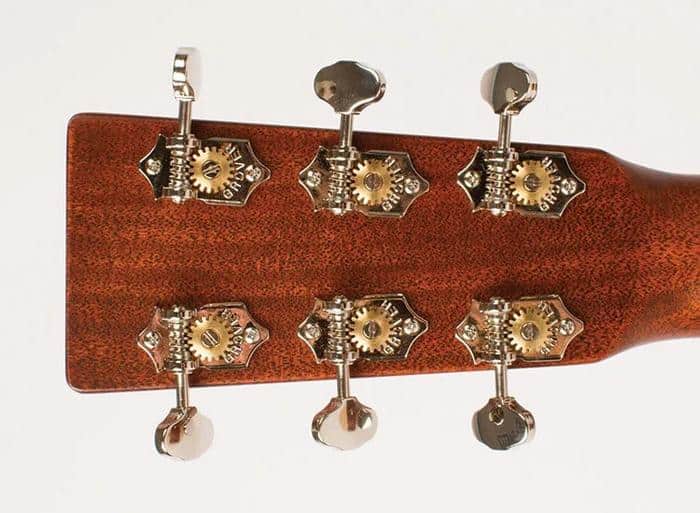Ever picked up a guitar and felt a stirring connection to the centuries-old tradition of music? Have you held the smooth curves of a classical guitar, fingers brushing over the authentic gut strings, and found yourself transported through time? As a luthier and researcher specializing in stringed instrument design, I first discovered this profound experience in 1994. An authentic gut strings guitar had fallen into my hands, and from that moment, a fascination was sparked that has weathered over two decades. The gut string guitar embodies an authenticity and storied history that transcends mere musical craftsmanship.
Through years of inspection, refinement, and exploration, I’ve become intimately familiar with the nuanced precision required for not just utilizing but truly understanding gut strings. This profound connection to the past is more than just an antiquarian fascination; it’s a powerful conduit in shaping a softer, more refined sound for the classical guitar. How does this magic happen? We’re about to embark on an enlightening journey to answer that very question, revealing the heart and soul of gut string guitars along the way.
From their unique tone and feel, and the history of their usage, to practical aspects such as purchasing, maintenance, and tuning stability, we will delve into everything you need to know about gut strings. Whether you’re a seasoned professional or a budding guitar enthusiast, this deep dive is designed to enrich your handling and understanding of authentic gut strings. Together, we’ll navigate through this unique realm of the guitar universe, connecting us with the centuries-old tradition of musical wonder.
Authentic Gut Strings: Unpacking the Characteristics
Gut String Tone and Feel

Delving deeper into the characteristics of gut strings, the inherent gut string tone and feel serve as their most distinguishing features. Indeed, the tone and feel of these strings are the bedrock of their authenticity, and it’s taken many jam sessions and experimental plucks to identify their majestic nuances.
Beginning with their tone, gut strings offer a sound that is unmistakably rich and warm. It’s almost like stepping back in time, as this gut string tone carries an old-world resonance that sets it apart from more modern alternatives. Notably, even among different gut strings, there’s variation in tonal quality which extends the musician’s expression.
Equal in importance is the gut string feel under your fingertips. Gut strings possess a raw, organic texture which reconnects players to the origins of guitar music. The playability is remarkable – just enough tension for quick fingerpicking but also providing a feedback loop of subtle vibrations. They call harder for calluses but bequeath the reward of an authentic playing experience.
Transformative as these aspects are, they weren’t immediately apparent to me. Numerous comparison recordings, minute adjustments, and a lot of listening in different settings were necessary. However, the beauty of the gut string tone and feel burgeoned as I became accustomed, creating a compelling soundscape that is invigoratingly distinct from other string types. They take time and patience to truly appreciate, but their rewards are unmatched in authenticity and musical depth.
As we move forward in our journey with gut strings, we’ll delve into the crucial considerations around gut string tension. This will help us better understand how to optimally utilize and appreciate this age-old technology in modern-day music.
Guitar String Tension of Gut Strings

Delving into the distinct aspects of gut strings, we arrive at a vital yet often overlooked factor: guitar string tension. In my years of exploring the world of luthiery, I’ve come to realize that tension is more than just a practical consideration – it’s deeply intertwined with the organic essence of gut strings.
Gut strings, by their nature, have a certain resilience. Their tension can vary considerably, depending upon factors like the gut’s density and thickness. Higher guitar string tension allows for the production of a louder, more resonant sound, and creates a unique balance between projection and playability.
However, amid these utilitarian considerations, we must appreciate the fact that this string tension isn’t contrived in factories. Instead, it stems from the innate structure of the gut – a testament to the direct influence of the material’s characteristics on the music we create.
It’s important to embrace this diversity in guitar string tension, as it conspicuously shapes the tonal palette these strings provide. Understanding this aspect helps us connect on a deeper level with our instruments, lending a nuanced touch to our music-making process. Through my work, it’s abundantly clear that gut strings aren’t just a historical relic, but an enduring symbol of authenticity that continues to enrich the guitar world with its sonic versatility.
As we venture further into our exploration of gut strings, let’s delve into their rich history, which will surely deepen our appreciation for these authentic tones.
The History of Gut Strings for Guitars

As I was inking an intricate depiction of a late Baroque period guitar for my latest historical musicology paper, my eyes couldn’t help but rest on the guitar strings. Translucently thin, almost ethereal, these historical guitar strings warranted extra strokes from my artistic brush, as well as deeper dives into my research instincts. I am, after all, not just an illustrator of instruments, but a dedicated history enthusiast, particularly attracted to the little details that often go unnoticed.
Here, I must confess, I feel a particularly strong emotional bond with those early music strings and the untold stories they carry, intertwined carefully within their delicate threads made of gut. As I follow their trail into the past, the melodic symphonies they’ve resonated continue to echo in my mind. The sound that once filled the gallant courts of the 17th century is now at the fingertips of modern guitar enthusiasts, providing the same authentic and looked-for tones.
Contrary to belief, gut strings aren’t a new fad but rooted in a rich history. Ready for a little time travel to the past?
Our journey begins in the atmospheric setting of the Renaissance era, where lutes, the precursors of our modern guitars, hummed with the vibrations of gut strings. Crafted from the twisted intestine of a sheep, an uncomfortable thought I admit, these strings were known for their superior tonal quality and almost unmatched resonance. Over time, this extraordinary tonality journeyed forward into the acoustic guitars of the Classical period, leaving an enchanting trail alongside the musical transformation.
The subsequent musical periods saw the fondness of gut strings soar high, revered by both classical guitarists and contemporary players alike for their rich, lush tonalities. However, with the advent of the Industrial Revolution and modern mass-production techniques, gut strings slowly stepped down from their throne, making way for metal and nylon strings, choices that proved more practical and inexpensive.
With modernization, the unique charm of gut strings unfortunately faded into the annals of guitar history, awaiting rediscovery.
In recent years, though, there has been a growing revival of gut strings in the world of guitar players, a reinfusion of the old into the new. Players, both seasoned and novice, are gradually rekindling their relationship with these historical guitar strings. The rich, warm nuances these strings offer are once again lightening up concert halls, studios, and even relaxed weekend jam sessions.
They are not a new fascination, as some might think. Instead, they are a cherished link, a tether back to our musical heritage. They remind us of the power of authenticity, even among the blast of super-synthetic alternatives. They are whispers from the past, echoing into the present, and thankfully, they are finally being heard more widely. The resurgence of gut strings is a testament to their timeless charm, inextricably woven into the fabric of music history itself.
A deep understanding of their history is the key to truly appreciating these unique strings. As I strum my guitar equipped with these strings, I feel connected to musicians of the past and the richness and depth their music carried. This connection transcends time, bridging a gap of centuries, and whispers a history that is so intriguing that who wouldn’t want to explore it?
Where and How to Buy Authentic Gut Strings
Popular Brands for Gut Strings

Having had the opportunity to interact with various string manufacturers, I’ve gathered some expert insights into the most popular brands for gut strings that I believe you will find valuable in your search for authentic gut strings.
LaBella basses are a renowned choice for gut strings. LaBella’s gut strings are traditional, authentic, and provide a warm and rich playing experience. Handcrafted with a meticulous process that ensures quality and durability, they are a testament to the company’s dedication to provide musicians with top-tier gear.
Another sought-after brand is Pyramid. Pyramid gut strings are beloved by many players for their vibrant tone, excellent pitch stability, and the sheer authenticity they bring to the table. Besides, Pyramid has been in the string manufacturing business for over a century, boasting a rich history and a reputation for producing strings used by professional musicians worldwide.
Choosing the right gut string depends on personal preference in terms of tone, feel, and tension. Both LaBella basses and Pyramid gut strings are solid choices based on their quality, performance, and faithful reproduction of historical authenticity. However, always ensure to buy from authorized dealers to avoid counterfeit products.
Having explored some popular brands for gut strings, we will delve into the differences and similarities of gut and nylon guitar strings in the next section, an essential aspect to consider when choosing the strings most suitable for your needs. As we progress, remember that our ultimate goal here is to guide you to finding the perfect string that would resonate in harmony with your guitar and playing style, making your music truly come alive.
Gut vs Nylon Guitar Strings: A Comparative Analysis
Tuning Stability and Longevity

While transitioning from the comparative analysis between gut and nylon guitar strings, it is essential to consider key factors such as tuning stability and string longevity. Both aspects directly influence the life span and overall performance of your guitar.
Having used both gut and nylon strings extensively, I’ve garnered valuable insights about their stability and longevity. Nylon strings, for example, generally need several hours of playing time before they stretch out and maintain stable tuning. Gut strings, on the other hand, can be more temperamental. They can be greatly affected by changes in temperature and humidity, demanding frequent tuning. However, once accustomed, the rich tones they offer is unparalleled.
String longevity is another notable point of difference. While gut strings deliver a strong and authentic sound, their lifespan isn’t as long as nylon counterparts. The organic material of gut strings is sensitive to variations in the environment, promoting quicker wear and tear. Nylon strings, in contrast, are synthetic and hence, offer higher durability and longer life in different conditions.
As a result of my firsthand experience, I’d say that if you primarily value tuning stability and string longevity, nylon strings offer a more reliable option. However, if you favor the originality and historical accuracy in sound, using gut strings can lead to a rewarding experience, despite the need for occasional adjustments and replacements. It is a balance of sound and practicality that each individual player must weigh.
To gauge the true value of these insights, it’s vital to remember our discussions on the characteristics, tone, tension, and history of gut strings. It’s a nuanced evaluation, with no wrong answer. Understanding tuning stability and longevity is one of the subtle facets that will profoundly influence your journey with the guitar.
Moving forward, we will delve into the intricacies of maintaining and using a gut strings guitar, another key aspect in your selection process. By understanding the dynamics of tuning stability and string longevity, you’re poised to make more informed decisions on this fascinating journey of music and sound.
Maintenance and Usage of Gut Strings Guitar
Tuning and Maintenance Tips

Transitioning into the specifics of gut strings maintenance, understanding the subtleties of their tuning is pivotal. It’s an incredibly delicate process that has significantly impacted my playing experience. Despite their fragile nature, gut strings boast unrivaled tonal beauty. Ensuring they maintain maximum vibrancy through regular tuning is critical.
In the delicate art of string tuning, I’ve learned that gut strings, in contrast to their nylon or steel counterparts, need a more precise touch. Misstep, and you risk a sharp snap and a broken string. Be sure to gently and gradually tighten the tuning pegs. An electronic tuner would offer an extra layer of precision, avoiding overstress on the strings.
Moving onto maintenance, it becomes clear that gut strings demand extra care. I’ve made it a practice to cleanse the strings gently with a soft cloth after playing to remove dust or sweat, prolonging their lifetime and keeping the tone quality intact. It’s part and parcel of making the most out of your guitar’s authentic gut strings.
Furthermore, I’ve found it beneficial to loosen the strings slightly during long periods of disuse. This mitigates potential tension build-up that could damage both strings and guitar neck. In a nutshell, proactive maintenance and precise tuning are essential for maximizing the durability and performance of gut strings.
Executing these tips over the years has vastly improved the quality and longevity of my gut strings. Keep in mind that each guitar has its own unique nuances. Thus, the process of mastering gut strings maintenance and tuning is a continuous journey of discovery and refinement. As we delve into common questions musicians have about using gut strings in the following section, we’ll address some further details to enhance your understanding.
FAQs
What is unique about gut strings for guitars?
Gut strings, which are typically made from sheep intestine, give a particularly rich and warm tone. They were the original strings for the classical guitar and are still considered the best for capturing the instrument’s historical and nuanced sound. They are also highly responsive to changes in touch and playing style.
What is the history of gut strings in the guitar world?
Evidence of gut strings being used on musical instruments date back to the ancient Egyptians. Crafting strings from animal gut was a common practice until the mid-20th century when synthetic materials become more prevalent. In guitars, gut strings were especially prominent in the Renaissance and Baroque eras, and they are still favoured today by many classical guitarists for their authentic sound.
What should I consider when purchasing gut strings for my guitar?
Consider the tone you are aiming for as gut strings are known for their warm, rich, and authentic sound. Check for string quality ensuring there are no imperfections as these could impact sound and longevity. Keep in mind that gut strings can be more expensive than synthetic ones and require more care and maintenance.
How can I best take care of my gut strings to maximize their lifespan?
After playing, wipe down the strings to remove any oil or dirt. Store your guitar in a controlled environment to avoid changes in temperature and humidity, which can cause the strings to wear out more quickly. The string’s lifespan will largely depend on how often you play, but regular care and maintenance can extend their use substantially.
Conclusion
It’s been quite a fascinating journey delving into the complexities and subtlety involved in gut strings and their role in guitar music. Throughout this exploration, my perspective regarding these natural gut guitar strings has certainly evolved. So, after this enlightening journey through the world of gut strings, how has your perspective changed?
In retrospect, the unique characteristics and historic significance of these gut strings indeed hold a unique charm. Their tone, feel, and tension are unlike other types of guitar strings, creating a texture and richness in sound that’s hard to replicate. The process of creating gut strings, especially the varnished gut strings, emphasizes their authenticity and the sheer craftsmanship involved in the process.
I’ve also learned that the purchase of authentic gut strings is not as straightforward as I initially assumed. It involves careful research of popular brands and trustworthy sources. Moreover, the comparison between gut and nylon guitar strings has shed light on why so many musicians, both professional and amateur, lean towards the former in their quest for a rich, authentic sound.
But perhaps what stands out the most is the uniqueness of the gut string’s tuning stability and longevity. Sure, they are prone to humidity and temperature fluctuations and require regular maintenance, but these aspects are nonetheless part of their charm. They demand dedication, precise tuning, and regular maintenance, all of which deepens the relationship between a musician and their instrument.
The depth and clarity of sound, the responsive touch, and nuanced control over expressive potential offered by gut strings are all part of the learning process, and they have led to a newfound appreciation for their role in guitar music. I hope that through sharing my own experiences and insights, you too feel motivated to explore the mystique of natural gut guitar strings and uncover their authenticity in your personal musical journey.